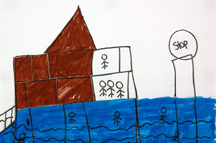|
Renaissance Village Art Therapy Trip #9 to
NOMA– Sept.
2007
By Karla Leopold LMFT, ATR, Fine Artist
 |
 |
There was an over whelming buzz
of excitement and enthusiasm in the air in mid-September at
Renaissance Village. When the art therapy team arrived at the
trailer park, a large group of residents greeted us with anticipation
and lots of questions. The children had big smiles on their
faces and greeted us with hugs. This was a long awaited day
for them and for the art therapy team. We were preparing to
take a trip with the children and their families back to New
Orleans two years after Hurricane Katrina, not to see the things
lost and left behind, but to view the art created by the community
of Renaissance Village. Katrina Through the Eyes of
Children was now being exhibited at the New Orleans
Museum of Art.
Sister Judith Brun, Leo Bonamy, Megan Perez and some of the
residents spent weeks organizing the trip, collecting permission
slips, recruiting volunteers, arranging meals and creating
interest in the trip. I had envisioned that there would be
one busload of residents going on the trip. When we talked
to Sister Judith prior to the week of our arrival, she had
filled over three busloads of interested participants;
over 100 people. Everyone wanted to go! She had faith that
it would all be fine and it certainly worked out that way!
Days prior to the trip, the team spent time organizing, handing
out T-shirts and created art preparing the participants for
what they would see. The therapists were concerned that without
preparation, close observation and follow-up, revisiting the
story of Hurricane Katrina would cause some participants to
be re-traumatized. Fortunately this was not a problem.
|
The
big day arrived and the tent was full of very excited children
and adults! The adults came dressed up. The children’s
faces were shinning and they were on their best behavior.
Local volunteers, students from the
LSU education program and members of Big Buddy’s
mentoring program joined us as chaperons. Reporters from
the New York Times, NPR and the Baton Rouge Advocate came
along as well as a photography and video crew to document
the day.
|
|
| |
 |
We loaded
the buses, with box lunches in hand, and set off for the two-hour
trip to New Orleans. Katrina had devastated the museum and
surrounding areas two years earlier, but on this day when we
arrived at the beautifully restructured grounds it looked stunning
with the sun shinning down on its white stone structure. |
|
| |
 |
It was quite a sight to see the
three busloads of people fill the large flight of stairs that
led to the front doors of the museum.
As we entered the museum, a small crowd of reporters, local dignitaries, museum
employees, and others that had been affected by Hurricane Katrina filled the
entryway. A piano was heard in the background and food was served. The museum
staff took care to make this a special day for us |
|
 |
|
|
After greetings from the museum director and staff, Sister
Judith and I said a few words. We were concerned that the children
who accompanied us would be disappointed if all of their art
wasn’t hung in the museum so I stressed that the art
that they were about to see was not necessarily the art that
each individual had created but a collection of art telling
their story. This was art created by their community for the
world to see.
|
| |
|
Entering the gallery accompanied
by the children who created the art took my breath away and
brought tears to my eyes. The art looked important framed on
the white walls of the gallery. The impact of the art portraying
the experience of Katrina and the aftermath as told through
the eyes of children was simple but powerful. The families
from Renaissance Village felt it, too. |
| |
|
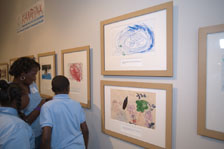 |
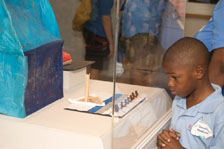 |
| |
|
One grandmother said, “The
exhibit was wonderful and important but it was really awful
that we had to live through the experiences displayed on the
walls to earn a place in a museum.”
The children found their art, their friend’s
art, photographs of people and places they knew. |
|
| |
|
They talked about creating art in the art therapy
sessions. Reporters, photographers, and video crew asked to
interview them and take their photos. The children had smiles
on their faces. They were very proud. |
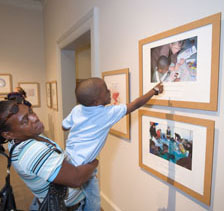 |
| |
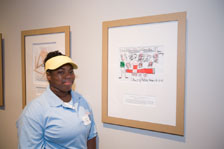 |
|
One young man
stood by his art with his father for hours posing for photos
and answering questions about his ant house creation. His father
said that this was one of the proudest days of his life and
was very thankful for the help his children had received with
the art therapy.
One man shared with me that this was
a really wonderful experience. He imagined that being in
the museum was like going to the White House in Washington,
DC. He was sure that a visit to the White House couldn’t
be anymore special than this.
Another young adult was overheard saying, “I didn’t
know that people like me were allowed in places like this,
but not only did I find out I can come here, I found out that
I can have my work hung on the walls. I’ll be coming
back.”
We loaded the buses in the afternoon
with happy, proud, tired and hungry people. The adventure
wasn’t over, as Sister
Judith had made reservations for all hundred plus of us to
eat dinner together at Piccadilly’s Restaurant, a popular
local cafeteria. At the restaurant the plates were filled with
good food and conversation about the day took place throughout
the room. Not only did the residents have a happy heart, they
had very full stomachs. It was a wonderful day for the people
who deserved it most, the people displaced by Hurricane Katrina.
In October 2005, when I first saw the
art created by the children during the art therapy sessions,
I knew the stories told through the art were very important
and needed to be preserved. The experiences created in the
art through the eyes of children told something important
about our nation’s history and
I wanted others to see what I was seeing. The vision of the
art exhibit became a shared vision with some very talented
people and it is now providing learning tools for the future;
tools to learn about trauma and it’s impact on children.
The exhibit reaches further. It validates the stories of the
people at Renaissance Village. It documents their role in one
of our Nation’s largest disasters. |
| |
|
And on September 16, 2007 at the New Orleans Museum of Art
over one hundred men, women and children from the community
that created the exhibit viewed Katrina Through the
Eyes of Children. It was a glorious day! It
was a vision fulfilled!
|
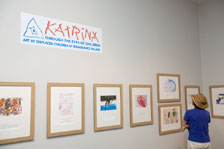 |
| |
|
Katrina Through the Eyes of Children, the mixed media art exhibit created by these children becomes more important with every visit. This story must be told!
<< Return to Project Background Home
|


